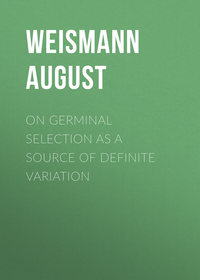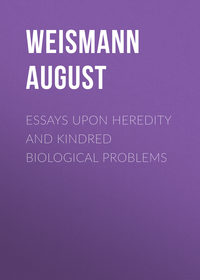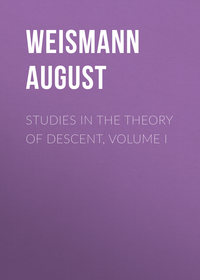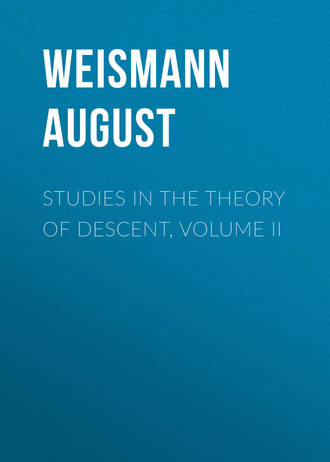 полная версия
полная версияStudies in the Theory of Descent, Volume II
From still another side there arises a similar disagreement. The larvæ of the genera Apatura and Nymphalis agree very closely in their bodily form and in their forked caudal appendage with the caterpillars of another sub-family of butterflies, the Satyrinæ, whilst their imagines differ chiefly from those of the latter sub-family in the absence of an enlargement of certain veins of the fore-wings, an essential character of the Satyrinæ.
This double disagreement has also been noticed by those systematists who have taken the form of the caterpillar into consideration. Thus, Morris11 attempted to incorporate the genera Apatura and Nymphalis into the family Libytheidæ, placing the latter as transitional from the Nymphalidæ to the Satyridæ. But although the imagines of the genera Apatura, Nymphalis, and Libythea may be most closely related – as I believe they actually are – the larvæ are widely different, being at least as different as are those of Apatura and Nymphalis from the remaining Nymphalinæ.
Now if we could safely raise Apatura and Nymphalis into a distinct family – an arrangement which in the estimation of Staudinger12 is correct – and if this were interpolated between the Satyridæ and Nymphalidæ, such an arrangement could only be based on the larval structure, and that of the imagines would thus remain unconsidered, since no other common characters can be found for these two genera than those which they possess in common with the other Nymphalideous genera.
The emperor-butterflies (Apatura), by the ocelli of their fore-wings certainly put us somewhat in mind of the Satyrinæ, in which such spots are always present; but this character does not occur in the genus Nymphalis, and is likewise absent in most of the other genera of this group. The genus Apatura shows in addition a most striking similarity in the markings of the wings to the purely Nymphalideous genus Limenitis, and it is therefore placed, by those systematists who leave this genus in the same family, in the closest proximity to Limenitis. This resemblance cannot depend upon mimicry, since not only one or another but all the species of the two genera possess a similar marking; and further, because similarity of marking alone does not constitute mimicry, but a resemblance in colour must also be added. The genus Limenitis actually contains a case of imitation, but in quite another direction; this will be treated of subsequently.
It cannot therefore be well denied that in this case the larvæ show different relationships to the imagines.
If the “natural” system is the expression of the genetic relationship of living forms, the question arises in this and in similar cases as to whether the more credence is to be attached to the larvæ or to the imagines – or, in more scientific phraseology, which of the two inherited classes of characters have been the most distinctly and completely preserved, and which of these, through its form-relationship, admits of the most distinct recognition of the blood-relationship, or, inversely, which has diverged the most widely from the ancestral form? The decision in single instances cannot but be difficult, and appears indeed at first sight impossible; nevertheless this will be arrived at in most cases as soon as the ontogeny of the larvæ, and therewith a portion of the phylogeny of this stage, can be accurately ascertained.
As in the Rhopalocera most of the families show a complete congruence in the form-relationship of the caterpillars and perfect insects, so a similar congruence is also found in the majority of the families belonging to other groups. Thus, the two allied families of the group Sphingina can also be very well characterized by their larvæ;13 both the Sphingidæ and the Sesiidæ possess throughout a characteristic form of larva.
Of the group Bombycina the family of the Saturniidæ possess thick cylindrical caterpillars, of which the segments are beset with a certain number of knob-like warts. It is true that two genera of this family (Endromis and Aglia) are without these characteristic warts, but the imagines of these genera also show extensive and common differences from those of the other genera. A distinct family has in fact already been based on these genera (Endromidæ, Boisd.). Thus the congruence is not thereby disturbed.
So also the families Liparidæ, Euprepiidæ, and Lithosiidæ appear sharply defined in both forms; and similar families occur likewise under the Noctuina, although in this group the erection of families presents great difficulties owing to the near relationship of the genera, and is always to some extent arbitrary. It is important, however, that it is precisely the transitional families which present intermediate forms both as larvæ and as imagines.
Such an instance is offered by the Acronyctidæ, a family belonging to the group Noctuina. The imagines here show in certain points an approximation to the group Bombycina; and their larvæ, which are thickly covered with hairs, likewise possess the characteristics of many of the caterpillars of this group.14
A second illustration is furnished by the family Ophiusidæ, which is still placed by all systematists under the Noctuina, its affinity to the Geometrina, however, being represented by its being located at the end of the Noctuina. The broad wings and narrow bodies of these moths remind us in fact of the appearance of the “geometers;” and the larvæ, like the imagines, show a striking resemblance to those of the Geometrina in the absence of the anterior abdominal legs. For this reason Hübner in his work on caterpillars has termed the species of this family “Semi-Geometræ.”
All these cases show a complete congruence in the two kinds of form-relationship; but exceptions are not wanting. Thus, the family Bombycidæ would certainly never have been formed if the larval structure only had been taken into consideration, since, whilst the genera Gastropacha, Clisiocampa, Lasiocampa, Odonestis, and their allies, are thickly covered with short silky hairs disposed in a very characteristic manner, the caterpillars of the genus Bombyx, to which the common silkworm, B. Mori, belongs, are quite naked and similar to many Sphinx-caterpillars (Chærocampa). Are the imagines of the genera united under this family, at any rate morphologically, as unequally related as their larvæ? Whether it is correct to combine them into one family is a question that does not belong here; we are now only concerned with the fact that the two stages are related in form in very different degrees.
An especially striking case of incongruence is offered by the family Notodontidæ, under which Boisduval, depending only on imaginal characters, united genera of which the larvæ differed to a very great extent. In O. Wilde’s work on caterpillars this family is on this account quite correctly characterized as follows: – “Larvæ of various forms, naked or with thin hairs, sixteen or fourteen legs.”15 In fact in the whole order Lepidoptera there can scarcely be found associated together such diverse larvæ as are here placed in one imago-family; on one side the short cylindrical caterpillars of the genus Cnethocampa, Steph. (C. Processionea, Pithyocampa, &c.), which are covered with fine, brittle, hooked hairs, and are very similar to the larvæ of Gastropacha with which they were formerly united; and on the other side there are the naked, humped, and flat-headed larvæ of the genus Harpyia, Ochs., with their two long forked appendages replacing the hindmost pair of legs, and the grotesquely formed caterpillars of the genera Stauropus, Germ., Hybocampa, Linn., and Notodonta, Ochs.
The morphological congruence between larvæ and imagines declares itself most sharply in genera, where it is the rule almost without exception. In this case we can indeed be sure that a genus or sub-genus founded on the imagines only will, in accordance with correct principles, present a corresponding difference in the larvæ. Had the latter been known first we should have been led to construct the same genera as those which are now established on the structure of the imagines, and these, through other circumstances, would have stood in the same degree of morphological relationship as the genera founded on the imagines. There is therefore a congruence in a double sense; in the first place the differences between the larvæ and imagines of any two genera are equally great, and, in the next place, the common characters possessed by these two stages combined cause them to form precisely the same groups defined with equal sharpness; the genera coincide completely.
So also the butterflies of the sub-family Nymphalinæ can well be separated into genera by the characters of the larvæ, and these, as far as I am able to judge, would agree with the genera founded on the imagines.
The genus Melitæa, for example, can be characterized by the possession of 7–9 fleshy tubercles bearing hairy spines; the genus Argynnis may be distinguished by always having six hairy unbranched spines on each segment, and the genus Cethosia by two similar spines on each segment; the genus Vanessa shows sometimes as many as seven branched spines; and the genus Limenitis never more than two branched blunt spines on each segment, and so forth. If we go further into details it will be seen that the most closely related imagines, as might indeed have been expected, likewise possess the most nearly allied larvæ, whilst very small differences between the imagines are also generally represented by corresponding differences in the larvæ. Thus, for instance, the genus Vanessa of Fabricius has been divided into several genera by later authors. Of these sub-genera, Grapta, Doubl. (containing the European C. – album, the American Fabricii, Interrogationis, Faunus, Comma, &c.), is distinguished by the fact that the larvæ not only possess branched spines on all the segments with the exception of the prothorax, but these spines are also present on the head; in the genus Vanessa (sensû strictiori), Doubl., the head and prothorax are spineless (e. g. V. Urticæ); in the tropical genus Junonia, Hübn., which was also formerly (Godart, 181916) united with Vanessa, the larvæ bear branched spines on all the segments, the head and prothorax included.
It is possible to go still further and to separate two species of Vanessa as two new genera, although they have hitherto been preserved from this fate even by the systematists most given to “splitting.” This decision is certainly justifiable, simply because these species at present stand quite alone, and the practical necessity of forming a distinct genus does not make itself felt, and this practical necessity moreover frequently comes into conflict with scientific claims: science erects a new genus based on the amount of morphological difference, it being quite immaterial whether one or many species make up this genus; such an excessive subdivision is, however, a hindrance to practical requirements, as the cumbrous array of names thereby becomes still further augmented.
The two species which I might separate from Vanessa on the ground of their greater divergence, are the very common and widely distributed V. Io and Antiopa, the Peacock Butterfly and the Camberwell Beauty. In the very remarkable pattern of their wings, both show most marked characteristics; Io possesses a large ocellus on each wing, and Antiopa has a broad light yellow border which is not found in any other species of Vanessa. There can be no doubt but that each of these would have been long ago raised into a genus if similarly marked species of Vanessa occurred in other parts of the world, as is the case with the other species of the genus. Thus, it is well known that there is a whole series of species resembling our V. Cardui, and another series resembling our V. C. – album, the two series possessing the same respective types of marking; indeed on these grounds the sub-genera Pyrameis and Grapta have been erected.17
I should not have considered it worth while to have made these remarks if it had not been for the fact that the caterpillars of V. Io and V. Antiopa differ in small particulars from one another and from the other species of the genus. These differences relate to the number and position of the spines, as can be seen from the following table: —
Species of the Genus Vanessa, Fabr.
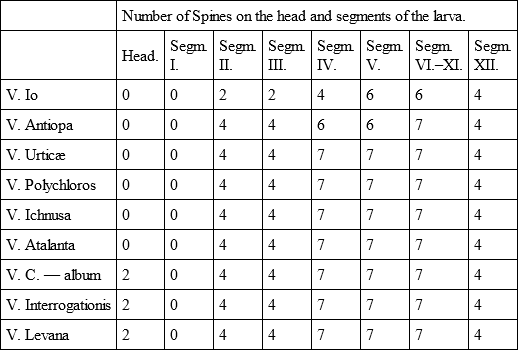
This character of the number of spines will not be considered as too unimportant when we observe how perfectly constant it remains in the nearly allied species. This is the case in the three consecutive forms, Urticæ, Polychloros, and Ichnusa. Now when we see that two species which differ in their imaginal characters present correspondingly small differences in their larvæ, this exact systematic congruence indicates a completely parallel phyletic development.
Exceptions are, however, to be met with here. Thus, Hübner has united one group of the species of Vanessa into the genus Pyrameis just mentioned, on account of certain characteristic distinctions of the butterflies. I do not know, however, how this genus admits of being grounded on the structure of the larvæ; the latter, as appears from the above table, agree exactly in the number and position of the spines with the caterpillars of Vanessa (sensû strictiori), nor can any common form of marking be detected which would enable them to be separated from Vanessa.
Still more striking is the incongruence in the genus Araschnia, Hübn. (A. Prorsa-Levana), which, like the genus Pyrameis, is entirely based on imaginal characters. This is distinguished from all the other sub-genera of the old genus Vanessa by a small difference in the venation of the wings (the discoidal cell of the hind-wings is open instead of closed). Now it is well-known that in butterflies the wing-venation, as most correctly shown by Herrich-Schäffer, is the safest criterion of “relationship.” It thus happens that this genus, typified by the common Levana, is in Kirby’s Catalogue separated from Vanessa by two genera, and according to Herrich-Schäffer18 by forty genera! Nevertheless, the larvæ agree so exactly in their spinal formula with Grapta that we should have no hesitation in regarding them as a species of this sub-genus. It appears to me very probable that in this case the form-relationship of the caterpillar gives more correct information as to the blood-relationship of the species than that of the imago – in any case the larvæ show a different form-relationship to the imagines.
Just as in the case of butterflies there are many genera of Sphingidæ which can be based on the structure of the larvæ, and which agree with those founded on the imagines.
Thus, the genus Macroglossa is characterized by a straight anal horn, a spherical head, and by a marking composed of longitudinal stripes, these characters not occurring elsewhere in this combination. The nearly allied genus Pterogon, on the other hand, cannot be based on the larvæ only, since not only is the marking of the adult larva very distinct in the different species, but the anal horn is present in two species, whilst in a third (P. Œnotheræ) it is replaced by a knob-like eye-spot. The genus Sphinx (sensû strictiori) is distinguished by the simple, curved caudal horn, the smooth, egg-shaped head and smooth skin, and by a marking mainly composed of seven oblique stripes. The genus Deilephila is distinguished from the preceding by a dorsal plate, situated on the prothorax and interrupting the marking, as well as by the pattern, which here consists of a subdorsal line with ring-spots more or less numerous and developed; the skin also is rough, “shagreened,” although it must be admitted that there are exceptions (Vespertilio). The genus Chærocampa admits also of being based on the form-relationship of its caterpillars, although this is certainly only possible by disregarding the marking and taking alone into consideration the peculiar pig-like form of the larvæ. The genus Acherontia, so nearly related to Sphinx, possesses in the doubly curved caudal horn a character common to the genus (three species known19). Finally may be mentioned the genus Smerinthus, of which the larvæ, by their anteriorly tapering form, their shagreened skin and almost triangular head with the apex upwards, their simply curved anal horn, and by their seven oblique stripes on each side, constitute a genus as sharply defined as that formed by the moths.
Although in all the systematic divisions hitherto treated of there are cases where the form-relationship of the larva does not completely coincide with that of the imago, such incongruences are of far more frequent occurrence in the smallest systematic group, viz. species.
The larvæ of two species have very frequently a much nearer form-relationship than their imagines. Thus, the caterpillars of Smerinthus Ocellatus and S. Populi are closely allied in structure, marking, and colouring, whilst the moths in these two last characters and in the form of the wings are widely separated.20 Judging from the larvæ we should expect to obtain two very similar moths, but in fact both Populi and Ocellatus have many near allies, and these closely related species sometimes possess larvæ which differ more widely than those of more distantly related species of imagines.
Thus, in Amur-land and North America there occur species of Smerinthus which closely resemble our Ocellatus in colour, marking, and form of wing, and which possess the characteristic large blue ocellus on the hind-wings. S. Excæcatus is quite correctly regarded as the representative American form of our Ocellatus, but its caterpillar, instead of being leaf-green, is of a chrome-yellow, and possesses dark green instead of white oblique stripes, and has moreover a number of red spots, and a red band on the head – in brief, in the very characters (colour and certain of the markings) in which the imagines completely agree it is widely different from Ocellatus. It appears also to be covered with short bristles, judging from Abbot and Smith’s figure.21
Just in the same way that the species having the nearest conceivable form-relationship to Ocellatus possesses a relatively strongly diverging larva, so does the nearest form-relation of Populi (imago) offer a parallel case. This species, which is also North American, lives on Juglans Alba. The imago of Smerinthus Juglandis differs considerably from S. Populi in the form of the wings, but it resembles the European species so closely in marking and colouring that no doubt can exist as to the near relationship of the two forms. The caterpillar of S. Juglandis,22 however, differs to a great extent from that of Populi in colour – it is not possible to confound these two larvæ; but those of Populi and Ocellatus are not only easily mistaken for one another, but are distinguished with difficulty even by experts.
In this same family of the Sphingidæ cases are not wanting in which, on the other hand, the moths are far more closely allied than the larvæ. This is especially striking in the genus Deilephila, eight species of which are allied in the imaginal state in a remarkable degree, whilst the larvæ differ greatly from one another in colour, and to as great an extent in marking. These eight species are D. Nicæa, Euphorbiæ, Dahlii, Galii, Livornica, Lineata, Zygophylli, and Hippophaës. Of these, Nicæa, Euphorbiæ, Dahlii, Zygophylli, and Hippophaës are so much alike in their whole structure, in the form of the wings, and in marking, that few entomologists can correctly identify them off-hand without comparison. The larvæ of these four species, however, are of very different appearances. Those of Euphorbiæ and Dahlii are most alike, both being distinguished by the possession of a double row of large ring-spots. Zygophylli (see Fig. 50, Pl. VI.) possesses only faint indications of ring-spots on a white subdorsal line; and in Hippophaës there is only an orange-red spot on the eleventh segment, the entire marking consisting of a subdorsal line on which, in some individuals, there are situated more or less developed ring-spots (see Figs. 59 and 60, Pl. VII.). If we only compare the larvæ and imagines of D. Euphorbiæ and Hippophaës, we cannot but be struck with astonishment at the great difference of form-relationship in the two stages of development.
In the case of D. Euphorbiæ and Nicæa this difference is almost greater. Whilst these larvæ show great differences in colour, marking, and in the roughness or smoothness of the skin (compare Fig. 51, Pl. VI. with Figs. 43 and 44, Pl. V.), the moths cannot be distinguished with certainty. As has already been stated, the imago of the rare D. Nicæa is for this reason wanting in most collections; it cannot be detected whether a specimen is genuine, i. e. whether it may not perhaps be a somewhat large example of D. Euphorbiæ.
An especially striking instance of incongruence is offered by the two species of Chærocampa most common with us, viz., Elpenor and Porcellus, the large and small Elephant Hawk-moths. The larvæ are so similar, even in the smallest details of marking, that they could scarcely be identified with certainty were it not that one species (Elpenor) is considerably larger and possesses a less curved caudal horn than the other. The moths of these two species much resemble one another in their dull green and red colours, but differ in the arrangement of these colours, i. e. in marking, and also in the form of their wings, to such an extent that Porcellus has been referred to the genus Pergesa23 of Walker. If systemy, as is admitted on many sides, has only to indicate the morphological relationship, this author is not to blame – but in this case a special larval classification must likewise be admitted, in a manner somewhat similar to that at present adopted provisionally in text-books of zoology for the Hydroid Polypes and inferior Medusæ. This case of Porcellus, however, shows that those are correct who maintain that systemy claims to express, although incompletely, the blood-relationship, and that systematists have always unconsciously formed their groups as though they intended to express the genetic connection of the forms. Only on this supposition can it appear incorrect to us to thus separate two species of which the larvæ agree so completely.
I cannot conclude this review of the various systematic groups without taking a glance at the groups comprised within species, viz. varieties. Whilst in species incongruence is of frequent occurrence, in varieties this is the rule, for which reason it admits in this case of being more sharply defined, since we are not concerned with a double difference but only with the question whether in the one stage a difference or an absolute similarity is observable. By far the majority of varieties are either simply imaginal or merely larval varieties – only the one stage diverges, the other is quite constant.
Thus, as has already been shown, in all the seasonally dimorphic butterflies known to me the caterpillars of the two generations of imagines, which are often so widely different, are exactly alike; and the same obtains for the majority of purely climatic varieties of butterflies. Unfortunately there are as yet no connected observations on this point. The only certain instance that I can here mention is that of the Alpine and Polar form of Pteris Napi. This variety, Bryoniæ, the female of which differs so greatly in marking and colouring, possesses larvæ which cannot be distinguished from those of the ordinary form of Napi.(See part I. appendix I. p. 124.)




